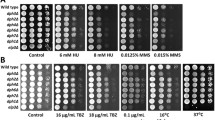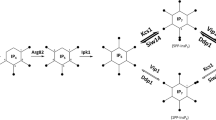Abstract
Polyamines are well-conserved, multifunctional polycations that contribute to a number of processes in the cells such as cell cycle, apoptosis, stress response, and gene expression. Therefore, polyamine levels should be kept under strict regulation by specific polyamine transporters and polyamine synthases. In this study, the aim is to experimentally characterize a predicted spermidine synthase gene srm1, which was identified upon sequence similarity, in fission yeast Schizosaccharomyces pombe. In an attempt to understand the role of this gene in cell cycle and stress response, deletion mutant of srm1 was generated and analyzed in terms of cell cycle regulation and environmental stress response. The results showed that srm1Δ cells had elongated cell size and were sensitive to osmotic stress, while they showed no sensitivity to DNA-damaging agents. To the best of our knowledge, this is the first experimental characterization of srm1 gene and its role in cell cycle progression and stress response.



Similar content being viewed by others
References
Bachrach U (1976) Polyamines as chemical markers of malignancy. Ital J Biochem 25:77–93
Bähler J, Wu JQ, Longtine MS (1998) Heterologous modules for efficient and versatile PCR-based gene targeting in Schizosaccharomyces pombe. Yeast 14(10):943–951. doi:10.1002/(SICI)1097-0061(199807)14:10<943::AID-YEA292>3.0.CO;2-Y
Balasundaram D, Tabor CW, Tabor H (1991) Spermidine or spermine is essential for the aerobic growth of Saccharomyces cerevisiae. Proc Natl Acad Sci USA 88:5872–5876
Barnett GR, Seyfzadeh M, Davis RH (1988) Putrescine and spermidine control degradation and synthesis of ornithine decarboxylase in Neurospora crassa. J Biol Chem 263:10005–10008
Birkholtz LM, Williams M, Niemand J, Louw AI, Persson L, Heby O (2011) Polyamine homoeostasis as a drug target in pathogenic protozoa: peculiarities and possibilities. Biochem J 438:229–244. doi:10.1042/BJ20110362
Casero RA Jr, Marton LJ (2007) Targeting polyamine metabolism and function in cancer and other hyperproliferative diseases. Nat Rev Drug Discov 6:373–390
Chattopadhyay MK, Tabor CW, Tabor H (2002) Absolute requirement of spermidine for growth and cell cycle progression of fission yeast (Schizosaccharomyces pombe). Proc Natl Acad Sci USA 99:10330–10334. doi:10.1073/pnas.162362899
Choi SH, Kim SW, Choi DH, Min BH, Chun BG (2000) Polyamine depletion induces p27Kip1 and enhances dexamethasone-induced G1 arrest and apoptosis in human T lymphoblastic leukemia cells. Leuk Res 24:119–127
Ernestus R, Röhn G, Schröder R, Els T, Klekner A, Paschen W, Klug N (2001) Polyamine metabolism in brain tumours: diagnostic relevance of quantitative biochemistry. J Neurol Neurosurg Psychiatry 71(1):88–92. doi:10.1136/jnnp.71.1.88
Fredlund JO, Johansson MC, Dahlberg E, Oredsson TM (1995) Ornithine decarboxylase and S-adenosylmethionine decarboxylase expression during the cell cycle of Chinese hamster ovary cells. Exp Cell Res 216:86–92. doi:10.1006/excr.1995.1011
Fredlund JO, Oredsson SM (1996) Normal G1/S transition and prolonged S phase within one cell cycle after seeding cells in the presence of an ornithine decarboxylase inhibitor. Cell Prolif 29:457–465
Fonzi WA (1989) Regulation of Saccharomyces cerevisiae ornithine decarboxylase expression in response to polyamine. J Biol Chem 264:18110–18118
Gesteland RF, Weiss RB, Atkins JF (1999) Recoding: reprogrammed genetic decoding. Science 257:1640–1641. doi:10.1126/science.1529352
Grassilli E, Desidero MA, Bellesia E, Salomoni P, Benatti F, Franceschi C (1995) Is polyamine desrease a common feature of apoptosis? Evidence from γ rays-and heat shock-induced cell death. Biochem Biophys Res Commun 216:708–714. doi:10.1006/bbrc.1995.2679
Güngör İ, Örs Gevrekci A (2016) The roles of SPBC409.08 and SPAC9.02c hypothetical genes in cell cycle and stress response, in Schizosaccharomyces pombe. Cell Mol Biol 62(4):42–47
Hamana K, Matsuzaki S (1992) Polyamines as a chemotaxonomic marker in bacterial systematics. Crit Rev Microbiol 18:261–283. doi:10.3109/10408419209113518
Hampel KJ, Crosson P, Lee JS (1991) Polyamines favour triplex DNA formation at neutral pH. BioChemistry 30:4455–4459
Heller JS, Fong WF, Canellakis ES (1976) Induction of a protein inhibitor to ornithine decarboxylase by the end products of its reaction. Proc Natl Acad Sci USA 73:1858–1862
Heby O, Persson L (1990) Molecular genetics of polyamine synthesis in eukaryotic cells. Trends Biochem Sci 15:153–158
Higashi K, Terui Y, Suganami A, Tamura Y, Nishimura K, Kashiwagi K, Igarashi K (2008) Selective structural change by spermidine in the bulged-out region of double-stranded RNA and its effect on RNA function. J Biol Chem 370(4):572–577. doi:10.1074/jbc.M806027200
Igarashi K, Kashiwagi K (1999) Polyamine transport in bacteria and yeast. Biochem J 344:633–642
IIgarashi K, Kashiwagi K (2000) Polyamines: mysterious modulators of cellular functions. Biochem Biophys Res Commun 271:559–564. doi:10.1006/bbrc.2000.2601
IIgarashi K, Kashiwagi K (2010) Modulation of cellular function by polyamines. Int J Biochem Cell Biol 42:39–51. doi:10.1016/j.biocel.2009.07.009
Ikeguchi Y, Bewley MC, Pegg AE (2006) Aminopropyltransferases: function, structure and genetics. J Biochem 139:1–9. doi:10.1093/jb/mvj019
Ivanov IP, Matsufuji S, Murakami Y, Gesteland RF, Atkins JF (2000) Conservation of polyamine regulation by translational frameshifting from yeast to mammals. EMBO 19(8):1907–1917. doi:10.1093/emboj/19.8.1907
Lee J, Sperandio V, Frantz DE, Longgood J, Camilli A, Phillips MA, Michael AJ (2009) An alternative polyamine biosynthetic pathway is widespread in bacteria and essential for biofilm formation in Vibrio cholerae. J Biol Chem 284(15):9899–9907. doi:10.1074/jbc.M900110200
Li X, Coffino P (1993) Degradation of ornithine decarboxylase: exposure of the C-terminal target by a polyamine-inducible inhibitory protein. Mol Cell Biol 13:2377–2383
Liu JH, Kitashiba H, Wang J, Ban Y, Moriguchi T (2007) Polyamines and their ability to provide environmental stress tolerance to plants. Plant Biotechnol 24:117–126. doi:10.5511/plantbiotechnology.24.117
Matthews HR (1993) Polyamines, chromatin structure and transcription. Bioessays 15:561–567. doi:10.1002/bies.950150811
Minguet EG, Vera-Sirera F, Marina A, Carbonell J, Blaquez MA (2008) Evolutionary diversification in polyamine biosynthesis. Mol Biol Evol 25(10):2119–2128. doi:10.1093/molbev/msn161
Moreno S, Klar A, Nurse P (1991) Molecular genetic analysis of fission yeast Schizosaccharomyces pombe. Methods Enzymol 194:795–823. doi:10.1016/0076-6879(91)94059-L
Murakami Y, Hayashi S (1985) Role of antizyme in degradation of ornithine decarboxylase in HTC cells. Biochem J 226:893–896
Niiranen K, Pietila M, Pirttila TJ, Jarvinen A, Halmekytö M, Korhonen V, Keinanen TA, Alhonen L, Janne Juhani (2002) Targeted disruption of spermidine/spermineN-acetyltransferase gene in mouse embryonic stem cells effects on polyamine homeostasis and sensitivity to polyamine analogues. J Biol Chem 277:25323–25328. doi:10.1074/jbc.M203599200
Nowotarski SL, Woster PM, Casero RA (2013) Polyamines and cancer: implications for chemotherapy and chemoprevention. Expert Rev Mol Med 15:e3. doi:10.1017/erm.2013.3
Pearce AK, Humphrey TC (2001) Integrating stress-response and cell-cycle checkpoint pathways. Trends Cell Biol 11(10):426–433. doi:10.1016/S0962-8924(01)02119-5
Persson L (2009) Polyamine homoeostasis. Essays Biochem 6:11–24. doi:10.1042/bse0460002
Roberts RW, Crothers DM (1992) Stability and properties of double and triple helices: dramatic effects of RNA or DNA backbone composition. Science 258:1463–1465
Russell P, Nurse P (1986) cdc25+ functions as an inducer in the mitotic control of fission yeast. Cell 45(1):145–153. doi:10.1016/0092-8674(86)90546-5
Sato M, Dhut S, Toda T (2005) New drug-resistant cassettes for gene disruption and epitope tagging in Schizosaccharomyces pombe. Yeast 22:583–591. doi:10.1002/yea.1233
Schipper RG, Penning LC, Verhofstad AA (2000) Involvement of polyamines in apoptosis. Facts and controversies: effectors or protectors? Semin Cancer Biol 10:55–68. doi:10.1006/scbi.2000.0308
Sprenger J, Svensson B, Halander J, Carey J, Persson L, Al-Karadaghia S (2015) Three-dimensional structures of Plasmodium falciparum spermidine synthase with bound inhibitors suggest new strategies for drug design. Acta Cryst 71:484–493. doi:10.1107/S1399004714027011
Teuber M, Azemi ME, Namjoyan F, Meier AC, Wodak A, Brandt W, Drager B (2007) Putrescine N-methyltransferases- a structure-function analysis. Plant Mol Biol 63:787–801. doi:10.1007/s11103-006-9126-7
Toth C, Coffino P (1999) Regulated degradation of yeast ornithine decarboxylase. J Biol Chem 274:25921–25926. doi:10.1074/jbc.274.36.25921
Williams LJ, Barnett GR, Ristow JL, Pitkin J, Perriere M, Davis RH (1992) Ornithine decarboxylase gene of Neurospora crassa: isolation, sequence and polyamine-mediated regulation of its mRNA. Mol Cell Biol 12:347–359
Wood E, Nurse P (2015) Sizing up to divide: mitotic cell-size control in fission yeast. Annu Rev Cell Dev Biol 31:11–29. doi:10.1146/annurev-cellbio-100814-125601
Acknowledgements
This work was supported by the TUBİTAK (The Scientific and Technological Research Council of Turkey) under the Grant 111T509.
Author information
Authors and Affiliations
Corresponding author
Rights and permissions
About this article
Cite this article
Gevrekci, A.Ö. Fission Yeast srm1 is Involved in Stress Response and Cell Cycle. Curr Microbiol 74, 725–731 (2017). https://doi.org/10.1007/s00284-017-1241-y
Received:
Accepted:
Published:
Issue Date:
DOI: https://doi.org/10.1007/s00284-017-1241-y




